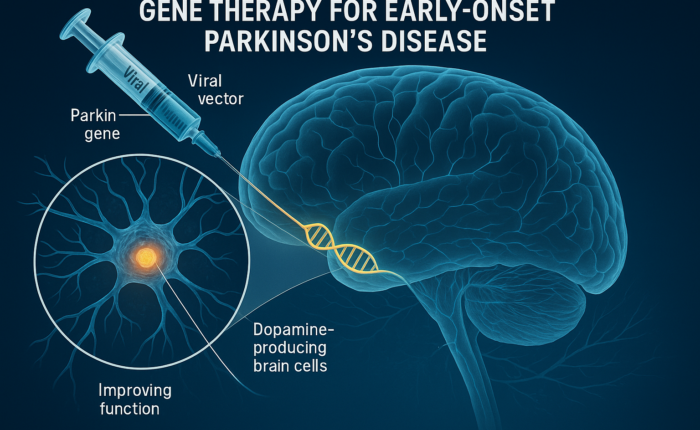A New Frontier: Gene Therapy Targeting Early-Onset Parkinson’s Disease

The search for transformative treatments for Parkinson’s disease (PD) has long focused on managing symptoms. But what if we could alter the very mechanism that triggers disease progression—especially in those diagnosed young due to a genetic mutation? This hope is fueling an exciting breakthrough backed by the California Institute for Regenerative Medicine (CIRM), where a $2.5 million grant is now funding a cutting-edge gene therapy targeting early-onset Parkinson’s caused by mutations in the Parkin gene.
Let’s walk through the science, promise, and implications of this game-changing therapy—especially for those in the Parkinson’s community diagnosed at a younger age.
Understanding Early-Onset Parkinson’s and the Parkin Gene
Unlike idiopathic Parkinson’s, which typically appears after age 60, early-onset PD can strike in people as young as their 20s or 30s. A common culprit in these younger cases is a mutation in the Parkin gene (PARK2), which disrupts mitochondrial function—the process by which cells produce energy.
Without functional Parkin protein, cells lose the ability to effectively recycle damaged mitochondria. Over time, this causes cell stress and death, especially in the dopamine-producing neurons of the substantia nigra. The result: early but rapidly escalating motor and non-motor symptoms.
The CIRM-Funded Solution: Restoring Parkin Function
Led by Dr. Jennifer Johnston, CEO of NysnoBio GT Neurology, this new gene therapy seeks to correct the problem at its source. The strategy? Deliver a healthy copy of the Parkin gene directly into affected cells.
This approach uses viral vectors to insert the correct genetic material into patients’ neurons. Once inside, cells are expected to begin producing the functional Parkin protein again—helping to clear out defective mitochondria and restore cellular balance.
According to CIRM’s Senior Science Officer Dr. Lisa McGinley, this is not just another symptomatic therapy. It’s a “disease-modifying treatment,” one that could potentially halt or reverse progression in patients with genetically driven PD.
Why This Matters to the Parkinson’s Community
Gene therapy offers several unprecedented advantages:
- Personalization: Targeting individuals with confirmed Parkin mutations makes this a highly specific intervention.
- Disease Modification: Unlike dopaminergic drugs that only address symptoms, gene therapy may actually stop or slow disease progression.
- One-Time Treatment Potential: If successful, a single administration could produce long-lasting effects—reducing the burden of lifelong daily medication.
Furthermore, while this specific treatment focuses on Parkin mutations, the principles could be extended to other genetic forms of PD, including mutations in LRRK2 or GBA. It also contributes to broader neurodegenerative disease research by advancing delivery methods and mitochondrial biology.
The Road Ahead: From Bench to Bedside
Currently, the therapy is in its preclinical translational phase. This means researchers are conducting studies in animal models and laboratory settings to confirm safety and efficacy before moving to human trials.
If all goes well, the next steps would include:
- FDA approval to begin Phase I clinical trials
- Recruitment of participants with genetically confirmed Parkin mutations
- Assessment of dosage, delivery methods, and long-term safety
The Parkinson’s research community is watching closely. A successful outcome could open the floodgates for gene-based interventions across the neurodegenerative spectrum.
The Bigger Picture: Building a Future of Precision Therapies
This isn’t an isolated case. A growing number of gene therapy strategies are emerging worldwide. From delivering enzymes that support dopamine synthesis to using neurotrophic factors that protect brain cells, gene therapy is helping reshape what’s possible in Parkinson’s care.
Initiatives like the one funded by CIRM highlight a shift in mindset—from symptom management to disease interception.
For individuals living with Parkinson’s, especially those with a known genetic cause, hope now comes not only from managing life day-to-day but from altering the course of the disease entirely.
Keywords within Context (SEO Integrated)
This breakthrough touches on early-onset Parkinson’s, Parkin gene mutation, gene therapy, and mitochondrial dysfunction—core issues in young patients facing progressive symptoms. The California Institute for Regenerative Medicine is backing this effort as part of its broader mission to develop regenerative therapies. By delivering healthy genes through viral vectors, scientists hope to restore cellular function, improve dopamine neuron survival, and reduce reliance on symptom-based Parkinson’s medications. This step could reshape the future of neurodegenerative treatment, moving us into a world where disease modification is a clinical reality, not a distant hope.
Final Keywords: gene therapy, Parkin gene, early-onset Parkinson’s, mitochondrial dysfunction, CIRM
Closing Note:
AI-generated medical infographics on Parkinson’s symptoms, treatment advances, and research findings; I hope you found this blog post informative and interesting. www.parkiesunite.com by Parkie
DALL·E Image Prompt:
Create a photo-realistic digital medical illustration showing gene therapy targeting early-onset Parkinson’s disease. Visualize a healthy Parkin gene being delivered via viral vector into dopamine-producing brain cells. Include a close-up of mitochondria improving in function, glowing more brightly in treated neurons. The brain should be semi-transparent, revealing neural circuits in the substantia nigra. Use a clinical, hopeful tone with precise labeling and a glowing aura around the repaired cells to show improvement.
Three 20-character taglines:
- “Genes Heal, Hope Grows”
- “Fix the Code, Fight PD”
- “Future Cures Start Here”
Negative Prompt:
Malformed limbs, extra limbs, mutated hands, disfigured face, bad anatomy, malformed hands, Text, lettering, captions, generating images with text overlays